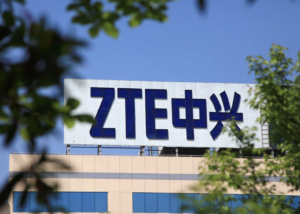ZTE and corporate cultural fever in China
Editor’s note: A version of this originally appeared on Sacha Cody’s blog and was written by Sacha Cody and Betty Luo. Sacha is an Anthropologist and China Studies scholar based in Shanghai. He holds a PhD in Anthropology from the Australian National University and is currently researching international Chinese enterprises. Betty Luo is a Research Analyst and consultant based in Shanghai.
ZTE’s (and perhaps Huawei’s soon) troubles in the US are interesting for several reasons. In this blog, we focus on a number of themes including the relationship between netizens’ response and the cultural fever of the 1980s.

We first learned of ZTE’s troubles on April 16th when news broke that the US Department of Commerce’s Bureau of Industry (BIS) hit the Chinese telecom equipment maker and consumer electronics manufacturer with a denial of export license. This means that ZTE is unable to purchase US made components they require for their products.
Why did BIS do this? The story goes back several years. Most recently, in March 2017, ZTE was fined $ 1.9 billion for their violation of export sanctions regarding North Korea and Iran (i.e. ZTE sold products to these nations containing US components). At the time, BIS attached a seven-year denial of export license ‘option’ that could be triggered if ZTE did not comply with the terms of the deal. BIS now claims ZTE made false statements in 2017, as well as earlier in 2016, and hence activated the denial order.
There are rich and nuanced opinions, commentary and analysis in the Chinese-language media. Three themes appear consistently: the reputation of international Chinese enterprises, techno-nationalism, and Chinese culture. Different media outlets take different stances.
Let’s begin with ZTE’s official response, though, which began by calling the order “extremely unfair.” In their press conference on April 20th, spokespersons said that this decision will severely impact 80,000 staff and their families, hundreds of operators as well as billions of end users around the world. Later, in their official statement, ZTE stated their interest in exploring judicial measures to protect the legal rights and interests of the company.
Turning to the official response, let us use the State-owned Assets Supervision and Administration Commission (SASAC) as an example. SASAC sits under the State Council; it is tasked with managing China’s state-owned enterprises (see this informative piece from The Economist about SASAC).
SASAC’s response was scathing. Perhaps because of its abruptness, its authenticity was disputed and the original report itself was later deleted. In it, they reviewed the entire story from 2012 and severely criticized ZTE’s dealings with the US authorities as “stupid and passive” (愚蠢和被动). SASAC stated that ZTE’s behavior not only damages the reputation of other international Chinese enterprises, but also the nation itself. It would be hard to get a more damning assessment. It is worth pointing out that SASAC has taken a strong interest in the image and reputation of international Chinese enterprises recently (see here), so they are paying a lot more attention to Chinese firms’ overseas activity.
SASAC also offered more cautioned advice, saying that China must learn valuable lessons from this episode and focus on indigenous innovation and the development of core technology. Experience and history, SASAC remind us, show that China cannot simply “buy” these.
Chinese netizens’ responses rekindled science and technology debates from the Hundred Days Reform (1898) and May Fourth Movement (1919). On the eve of Chinese modernity, activists and reformers attempting to save the nation linked the development of science and technology—as well as business and industry—to China’s survival. Throughout the twentieth century, technological prowess and the fate of the nation have become inextricably intertwined and formed a political and cultural discourse that political analyst Evan Feigenbaum calls “techno-nationalism.”
Netizens are looking inwards; their responses reveal a mini cultural fever bubbling away. Cultural Fever (文化热 wenhua re) is the name given to the period 1984–1989 when intellectuals and other urbanites debated the extent to which China’s cultural tradition was holding back reform efforts.
Some netizens outlined what they see as the core issue: Chinese firms are hampered by low R&D spending. They benchmarked Chinese firms with Western MNCs including Microsoft, Intel, Google, and Apple.
But the ZTE story has many netizens asking more philosophical questions as they probe why China has not yet developed its own top-grade technologies despite so much progress in other areas. These netizens point out that as of today, Chinese core technology is really only suitable for consumer products, but not for telecommunications, military, industrial or pharmaceutical applications. This makes China reliant on others.
These are interesting perspectives; scholars have differing opinions and some point out the likelihood of global technology leadership from China.
One group of netizens posed rather uncomfortable questions concerning Chinese corporate culture—sometimes called “wolf culture” and celebrated by firms such as Huawei—and commercial practices. These netizens wonder why large international firms like Huawei can be so successful when it comes to AI yet lag behind in integrated circuit (IC) chips. They speculate: “Because of the hard-working spirit of the Chinese, Huawei staff will work all night if the client needs a new feature. But what they forgot is that these all work off [someone else’s] hardware and IC.”
These netizens are deeply critical of the temporal outlook of Chinese industry, pointing out that the development of core technology takes time. Universities, some say, are not investing in core technologies, preferring projects with a faster turn-around time. “We’re not patient enough to work on something that won’t pay off in the short term”, explained one.
In what was a well-timed response, President Xi made a call to arms during a recent trip through Hubei when he visited several Chinese chip makers and, in calling for self-reliance, settled the matter.